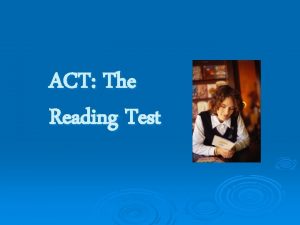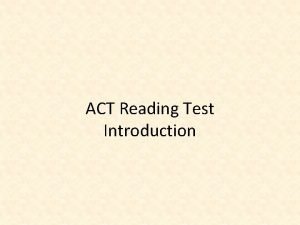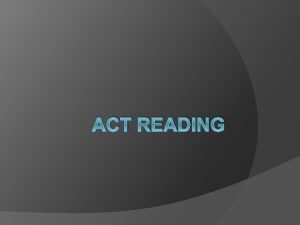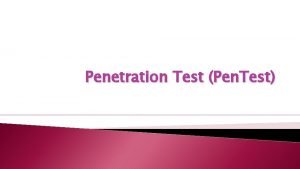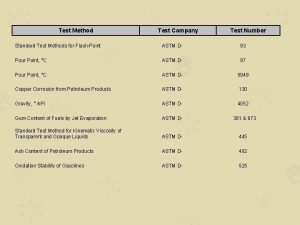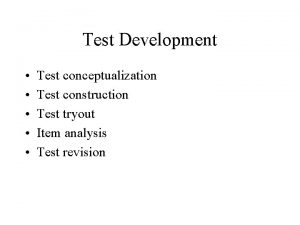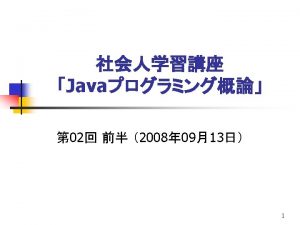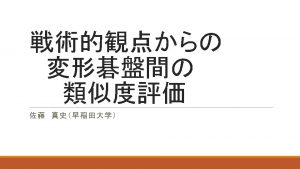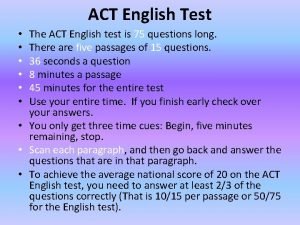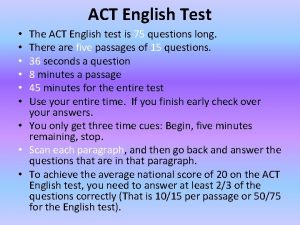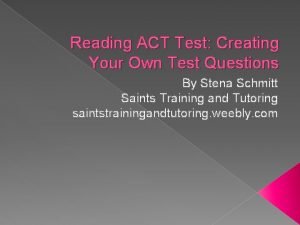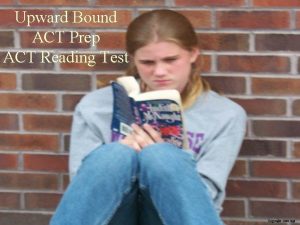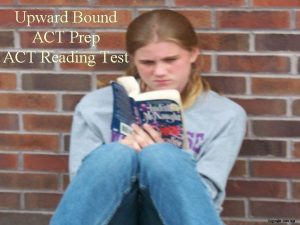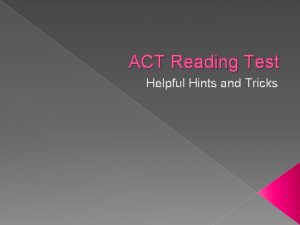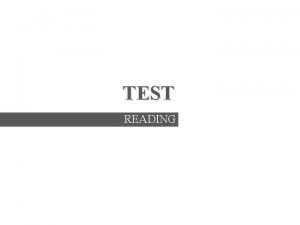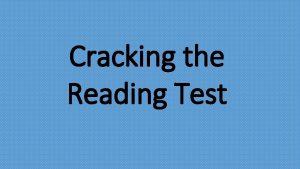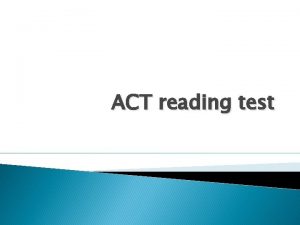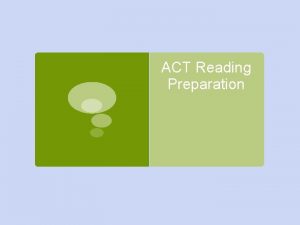The ACT Reading Test Reading on the ACT
























- Slides: 24

The ACT Reading Test Reading on the ACT is not the same as reading for school. When you’re reading for school, you have to understand what you’ve read and be able to discuss it. On the ACT, you only have to understand enough of the passage to answer the questions. You don’t need to discuss the passage later.

What it is. . . 4 passages with 10 questions each. • That’s 40 questions total. • You get 35 minutes for the entire test. • That means you have approximately 9 minutes to cover each passage and the questions that follow it. • If you work on your pacing strategies, you will be able to complete all 4 passages. •

The passages are edited pieces of books and magazines. According to the ACT, they are “typical of what a college freshman might be required to read …” The ACT questions are designed to ask you what is directly stated in the passage AND what is indirectly stated (implied meanings). According to the ACT, the questions are supposed to test your ability to “understand” the passages.

But That’s Not Really True: No one ever achieved a great insight by spending eight or nine very pressured minutes reading an isolated fragment of a book or a journal article. Serious writers don’t intend for their works to be read in fragments or in a hurried fashion. Serious readers take time to think about the things they read.

What It Really Is: During the ACT Reading test, you’re not being asked to understand anything. You’re not asked to do anything that you will ever do in college. ◦ Any professor will tell you that true understanding takes thought, and thought usually takes time. On the ACT Reading test, you’re simply asked to take a “reading test. ” Period.

So Be Wise to the Test: You’ll raise your reading score if you think strategically. 1. Work the passages in the order that best suits you. 2. See through the traps and distracters that hide correct answer choices. 3. Identify incorrect answers and eliminate them quickly. 4. Answer questions without really reading the passage.

Ordering the Passages: The Reading test has four passages, one each from the following fields: 1. Prose Fiction 2. Social Sciences 3. Humanities 4. Natural Sciences The passages are always in the same order. Students differ in their abilities to tackle these different passage types, and it’s important that you decide which passages are easiest and hardest for you.

Prose Fiction Passages These passages are short stories or excerpts from short stories or novels. Most prose fiction passages are primarily concerned with the following 5 things: 1. Who 2. What 3. When 4. Where 5. Why

Social Science and Humanities Passages: In these passages, the author has views about the subject he or she is discussing, and you might be asked to draw inferences about them. You might also be asked questions about details.

Social Sciences Topics: � � � Anthropology Archaeology Biography Business Economics Education � Geography � History � Political science � Psychology � Sociology

Humanities Topics: Architecture Art Dance Ethics Film Language Literary criticism Music Philosophy Radio Television Theatre

Natural Science Passages: Natural Science passages are filled with lots of details and technical descriptions. Anatomy Astronomy Biology Botany Chemistry Ecology Geology Medicine Meteorology Microbiology Natural history Physics Technology Zoology

So What Do I Do First? ? ? READ THE BLURB!!! What’s the blurb, you ask? The blurb gives you important information about the passage. Don’t skip it!

But I Hate Them All! How to Tell Which Passages you Find Easy ad Hard Look at the user-friendliness of the topics themselves ◦ You don’t have to love a topic to take advantage of familiarity with it. Look at the user-friendliness of the questions and answer choices ◦ Do the questions direct you to particular lines in the passage, refer to dates, refer to proper nouns, or refer to italicized words? Ordering passages takes a little time at the beginning, but it can save you a lot of time (and gain you points) in the end.

Reading Strategies Preview the test and look for passages with the shortest questions first. Always work to YOUR strengths.

Preview the questions in each passage and find the passage with shorter questions/answers. Do this passage first. If they all seem the same, go with your strengths; choose your best subject. 14. Which of the following most accurately states the main idea of the fifth paragraph (lines 57 -77)? Takes lots of time to read F. Studies conducted in the 1980 s that established a connection between customer loyalty and employee loyalty have since been challenged by investors G. Company profitability is doomed as long as corporate policies are conducive to a superficial Takes less treatment of customers. time H. Company success is linked to practices that to read acknowledge the complex relationships among customers, employees, and investors. J. As a result of the complexity of the loyalty issue in business, an increasing number of companies are hiring consultants to devise profit strategies. 5. It is implied in the eighth paragraph (lines 39 -59) that Lil applies Gordon’s theories about people’s appearances in spite of her: A. B. C. D. conscience. children. parents. education.

How to take the test: There are two general theories for how best to take the ACT Reading test: ◦ The first method is probably the one you’re most comfortable with. ◦ Quickly skim the passage, underlining what you believe to be the key words and phrases (what’s important). Make key notes of one or two words in the margins as to the topic of the paragraph.

An alternative method: Look at the questions first (do not read the answers) Underline key words and phrases and all line references in the questions. Quickly review the test and find those key words, phrases, and line references. Mark the question number in the margin of the passage. Many people have found this to help tremendously when dealing with text containing multiple line references, facts, or definitions.

14. The author indicates that the common factor in the events and periods listed in lines 50 - 54 is that they: – Draw a reference line by the paragraph line numbers addressed in the question. – Write the number of the question by the reference line.


TRAPS on the READING TEST

1. BE VERY CAREFUL OF answer choices that use EXACT WORDING from the passage. They are usually incorrect because the question presents the information differently from the text. Most correct answers are paraphrases of the text. In other words, they say the same thing using different words.

Words such as always, never, all, completely, totally, only, every, absolutely signal a trap because they make a statement for which there can be no exceptions and are therefore wrong. REMEMBER: If a single word in the answer is wrong, the entire answer is wrong and can be crossed off!

 Pre reading while reading and post reading activities
Pre reading while reading and post reading activities Macbeth act 2 summary
Macbeth act 2 summary Hình ảnh bộ gõ cơ thể búng tay
Hình ảnh bộ gõ cơ thể búng tay Ng-html
Ng-html Bổ thể
Bổ thể Tỉ lệ cơ thể trẻ em
Tỉ lệ cơ thể trẻ em Voi kéo gỗ như thế nào
Voi kéo gỗ như thế nào Glasgow thang điểm
Glasgow thang điểm Hát lên người ơi
Hát lên người ơi Các môn thể thao bắt đầu bằng tiếng chạy
Các môn thể thao bắt đầu bằng tiếng chạy Thế nào là hệ số cao nhất
Thế nào là hệ số cao nhất Các châu lục và đại dương trên thế giới
Các châu lục và đại dương trên thế giới Công thức tính thế năng
Công thức tính thế năng Trời xanh đây là của chúng ta thể thơ
Trời xanh đây là của chúng ta thể thơ Cách giải mật thư tọa độ
Cách giải mật thư tọa độ Làm thế nào để 102-1=99
Làm thế nào để 102-1=99 độ dài liên kết
độ dài liên kết Các châu lục và đại dương trên thế giới
Các châu lục và đại dương trên thế giới Thể thơ truyền thống
Thể thơ truyền thống Quá trình desamine hóa có thể tạo ra
Quá trình desamine hóa có thể tạo ra Một số thể thơ truyền thống
Một số thể thơ truyền thống Cái miệng xinh xinh thế chỉ nói điều hay thôi
Cái miệng xinh xinh thế chỉ nói điều hay thôi Vẽ hình chiếu vuông góc của vật thể sau
Vẽ hình chiếu vuông góc của vật thể sau Nguyên nhân của sự mỏi cơ sinh 8
Nguyên nhân của sự mỏi cơ sinh 8 đặc điểm cơ thể của người tối cổ
đặc điểm cơ thể của người tối cổ

























